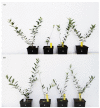Antifungal Activity of Propyl-Propane-Thiosulfinate (PTS) and Propyl-Propane-Thiosulfonate (PTSO) from Allium cepa against Verticillium dahliae: In Vitro and in Planta Assays
- PMID: 34575774
- PMCID: PMC8469426
- DOI: 10.3390/jof7090736
Antifungal Activity of Propyl-Propane-Thiosulfinate (PTS) and Propyl-Propane-Thiosulfonate (PTSO) from Allium cepa against Verticillium dahliae: In Vitro and in Planta Assays
Abstract
Verticillium wilt, caused by Verticillium dahliae, is the most devastating soil-borne fungal disease of olive trees worldwide. Currently, there is no effective measure available to control the pathogen in diseased plants in open field conditions. Searching more effective and sustainable solutions are a priority for the olive sector. The existing alternatives for disease control include the use of biological control microorganisms and compounds of natural origin from plants, such as Alliaceae. Propyl propane thiosulfinate (PTS) and propyl propane thiosulfonate (PTSO) are two organosulfur compounds derived from Allium cepa with a widely documented antimicrobial activity. The aim of this study was to evaluate the antifungal activity of PTS and PTSO against the defoliating and non-defoliating V. dahliae pathotypes. Firstly, several in vitro tests were performed (Minimum Antifungal Concentration, susceptibility studies according to the Kirby-Bauer disk-diffusion method, antifungal activity through aerial diffusion and effect on mycelial growth). The ability of both compounds to sanitize soil was evaluated using a sterile substrate inoculated with V. dahliae. Finally, challenges in growth chambers were carried out. PTS and PTSO generated growth inhibition zones in agar diffusion and the gas phase, and the mycelial growth of all the V. dahliae strains was significantly altered. The V. dahliae population in soil was considerably reduced after the sanitization. Finally, in planta assays demonstrated the ability of these compounds to reduce disease related parameters and their contribution to control the phytopathogen. In conclusion, the results showed that the PTS and PTSO from Allium cepa display in vitro and in vivo antifungal activity against V. dahliae and suggested that both compounds could be used as natural and environmentally friendly tools for Verticillium wilt management.
Keywords: Verticillium wilt; olive trees; onion; organosulfur compounds; pest management.
Conflict of interest statement
Authors declare no conflict of interest.
Figures






References
-
- Landa B.B., Pérez A.G., Luaces P., Montes-Borrego M., Navas-Cortés J.A., Sanz C. Insights Into the Effect of Verticillium dahliae Defoliating-Pathotype Infection on the Content of Phenolic and Volatile Compounds Related to the Sensory Properties of Virgin Olive Oil. Front. Plant Sci. 2019;10:232. doi: 10.3389/fpls.2019.00232. - DOI - PMC - PubMed
-
- Gramaje D., Pérez-Serrano V., Borrego M.M., Navas-Cortes J., Díaz R.M.J., Landa B.B. A Comparison of Real-Time PCR Protocols for the Quantitative Monitoring of Asymptomatic Olive Infections by Verticillium dahliae Pathotypes. Phytopathology. 2013;103:1058–1068. doi: 10.1094/PHYTO-11-12-0312-R. - DOI - PubMed
-
- Navas-Cortés J.A., Landa B.B., Mercado-Blanco J., Trapero-Casas J.L., Jurado R., Jiménez-Díaz R.M. Spatiotemporal Analysis of Spread of Infections by Verticillium dahliae Pathotypes within a High Tree Density Olive Orchard in Southern Spain. Phytopathology. 2008;98:167–180. doi: 10.1094/PHYTO-98-2-0167. - DOI - PubMed
-
- Keykhasaber M., Thomma B.P.H.J., Hiemstra J.A. Verticillium wilt caused by Verticillium dahliae in woody plants with emphasis on olive and shade trees. Eur. J. Plant Pathol. 2018;150:21–37. doi: 10.1007/s10658-017-1273-y. - DOI
LinkOut - more resources
Full Text Sources

